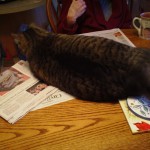Today my novel’s first proofs are staring at me. They’re due soon and I will be humiliated if any errata slips into print. But I’m resisting diving into the copy editing mode. That leads me to stall by reminding my students and readers that copyediting is not the same as critique or self-editing. When a student tells me they’ve edited or had their writing edited, I always wonder what the writer means. Proofreading? I wish it were that easy. Many of my writer students hear me harping on them about structure, about how their stories unfold. All good. Nobody wants to read a perfectly puncuated weak story.
Still, in my classes, revision can mean “big picture” items such as theme, content and story structure or it can also mean editing for usage, sentence construction and yes, the little things like periods or paragraph indents that often escape us at first read.
Those little things are as important as the big picture. More than anything, small style errors make the writer seem amateurish. Take the time to find out correct usage, grammar, spelling and puncuation. Doing so strengthens your committment to excellence in writing and helps you compete for publishing ink. Guess I’d better take my own advice and get at those proofs.
Writing Tip for Today: Is there an area of those “little things” where you aren’t sure about the rule? Pick up your copy of Strunk & White’s Elements of Style, and look up the correct form. Then practice it. Details matter.
Ready to take your writing to the next level? e-mail me




